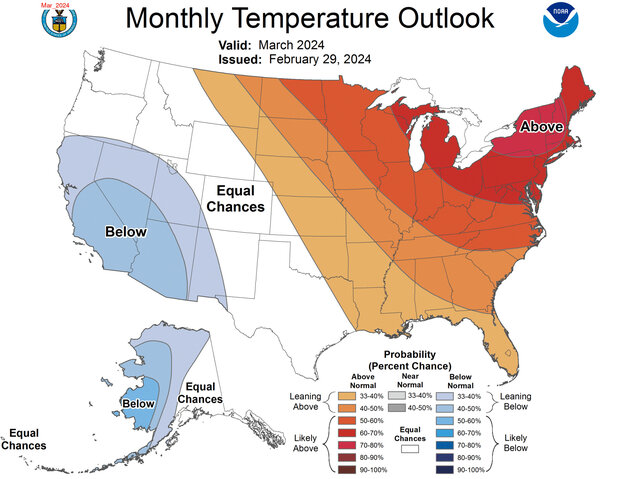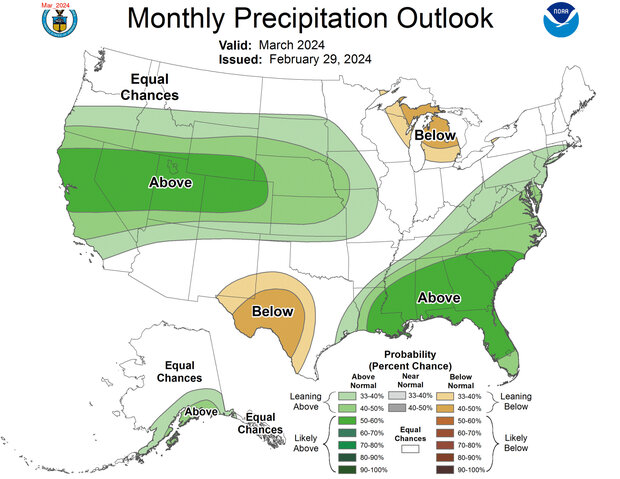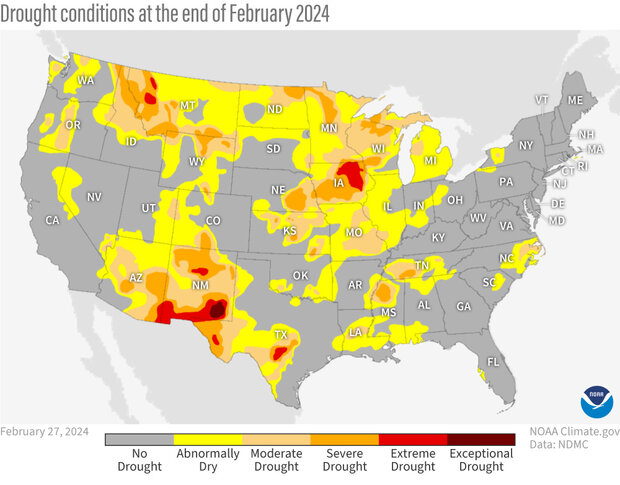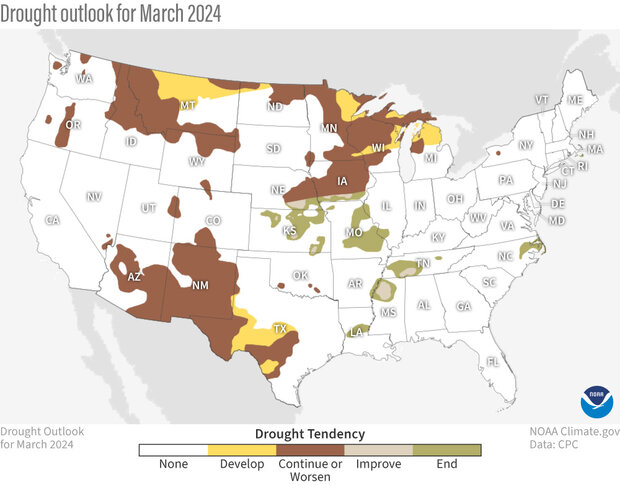U.S. climate outlook for March 2024
Meteorological winter is now in the rearview mirror, and once again, winter was largely a big disappointment for cold and snow lovers across most of the United States. Despite the first measurable snowfall in the large cities of the Northeast in about 2 years, winter snow totals in that region were again well below average, and temperatures across the country averaged above normal from coast to coast, likely resulting in the warmest winter in the historical record for the country. (NOAA will release the national climate summary for February and the 2023-24 winter this Friday, March 8). Cold and snowy weather can still occur during March, so let’s see what NOAA’s Climate Prediction Center (CPC) predicts for the upcoming month. Will the mild weather continue or will Mother Nature finally deliver some cold and snow to the country?
The temperature outlook for March 2024, showing where the average temperature is favored to be much warmer than average (orange and red), near average (gray), or much cooler than average (blues). Darker colors mean higher chances, not more extreme temperatures. White areas mean that there are equal chances for a warm, cool, or near-average March. Much warmer or much cooler than average means "in the upper or lower third" of March temperatures from 1991-2020. For more details on how to interpret these maps, read our explainer Understanding NOAA's monthly climate outlooks.
On February 29, CPC released its updated monthly climate outlooks for temperature, precipitation, and drought across the United States for March 2024. The temperature outlook favors well above normal temperatures across much of the central and eastern parts of the nation, with well below average temperatures favored in California and parts of the Southwest. The precipitation outlook favors well above average precipitation (rain and/or snow) across large parts of the western, central, and eastern parts of the country, with well below average precipitation only favored in small parts of the Upper Midwest and Southern Plains.
The precipitation outlook for March 2024, showing where the average precipitation (rain and snow) is favored to be much higher than average (greens), near average (gray), or much lower than average (browns). Darker colors mean higher chances, not more extreme precipitation departures. White areas mean that there are equal chances for a wet, dry, or near-average March. Much higher or much lower than average means "in the upper or lower third" of March precipitation amounts from 1991-2020. For more details on how to interpret these maps, read our explainer Understanding NOAA's monthly climate outlooks.
Below, I’ll provide more detail about the outlooks and discuss the basis for them. I’ll also examine the current state of drought, how it changed during the prior month and winter, and how CPC expects drought to change during March. Also, remember that the colors on the temperature and precipitation outlook maps only provide information about the most likely outcome, but other outcomes are still possible, although less likely to occur. More details about interpreting the outlooks can be found here.
The updated outlooks were produced considering the Week 1 forecast from the Weather Prediction Center (WPC), and CPC’s own Week 2 and Week 3-4 outlooks. Other tools that forecasters examined this month were longer-range forecast models such as the Global Ensemble Forecast System (GEFS), the Climate Forecast System (CFSv2), and products derived from these models.
El Niño began to weaken during February across the tropical Pacific as expected, but despite weakening, it was still categorized as strong, with impacts to the global climate likely continuing for the next few months. Therefore, it was again considered as the dominant teleconnection for the March outlooks. The Madden-Julian Oscillation (MJO)—a conjoined area of heavy rains and clear, calm skies that travel the tropics together as a couplet—remained active, with its heavy rains located over the Indian Ocean at the end of February. Since computer models are in good agreement for it to strengthen and propagate eastward across the Maritime continent during the first half of March, MJO impacts also played a role in the March Outlooks.
Temperature outlook
The March temperature outlook favors well above average temperatures on a line from central Montana southeastward through eastern Texas and all locations eastward. In contrast, well below average temperatures are favored in California and parts of the Southwest. The highest odds for a warmer-than-average March reside in the Northeast, where probabilities exceed 70%. Maximum probabilities for below-average out West are more modest, topping out at less than 50%.
Well above average temperatures are strongly favored in the eastern half of the nation during the first two weeks of the month. Confidence is quite high in the Northeast, as the location of the MJO will favor ridging (jet stream shifted north of its normal position) over eastern North America during the first 2 weeks of the month, which agrees quite well with short-, medium-, and longer-range model forecasts. Although probabilities for warmth are lower, CPC’s week 3-4 temperature outlook also favors above-average temperatures during the end of March for the northeastern quarter of the country. With odds also favoring above-average temperatures in all CPC outlooks, probabilities exceed 50% in the Midwest, Ohio Valley and mid-Atlantic states.
Odds for below-average temperatures encompass much of the Southwest and California. Predicted troughing (jet stream shifted south of its normal position) during the first 2 weeks of the month (also consistent with MJO guidance) should result in a colder-than-normal first half of the month. However, the longer-range outlook has more uncertainty, so averaged over the month, forecasters give the outlook fairly low odds.
Precipitation outlook
Well above average precipitation is favored across large parts of the nation during March, in areas stretching from the West Coast eastward to the central Great Plains and from the Gulf Coast extending up the Eastern Seaboard to southern New England. Probabilities for a wet March are highest across central and northern California, across Nevada and Utah into Colorado, and in much of the Southeast (exceeding 50%). El Niño background conditions and the MJO both favor above-normal precipitation in these areas, as do current computer model forecasts for both the short (Week-1) and medium (Week-2) range. The week 3-4 precipitation outlook also favors above-average precipitation along the entire East Coast and in parts of the West.
Well below average precipitation is only favored in small parts of the Great Lakes region and in western and central Texas. However, the probability for dryness in both areas is less than 50% due to “mixed signals” for precipitation between the first and second halves of the month. For the first half of March, CPC’s 6-10-day and Week-2 outlooks tilt toward normal or even above-average precipitation across much of the country, including these regions. The first week of March appears quite dry in Texas, while the week 3-4 precipitation outlook tilts toward below-average in the western Great Lakes region.
Drought Monitor
Drought across the continuous United States decreased from about 23.5% at the end of January to close to 20% by the end of February, with around a 15% improvement in drought coverage during the winter overall. Additionally, the percent of the country in the two most intense categories (D3-D4, representing extreme and exceptional drought) decreased from around 2.5% to about 1.5% during February, with an overall improvement from 7.5% in early December. The current amount of extreme or exceptional drought is the lowest amount since June 2020.
Drought conditions across the contiguous United States as of February 27, 2024. Only a few parts of the country were still experiencing extreme (red) or exceptional (dark red) drought. NOAA Climate.gov map, based on data from the U.S. Drought Monitor Project. For more on drought, visit Drought.gov.
Precipitation during the winter was generally above average in the Pacific Northwest, in the Southwest, along the Gulf Coast, and in the mid-Atlantic, all resulting in drought improvement. The most significant drought improvement occurred in the lower Mississippi Valley, where improvements of up to 5 classes (and complete drought removal) was recorded. Drought removal was also observed in parts of the Southeast and Mid-Atlantic, with 3-4 class improvement common. Improvement of 2-3 classes and drought removal was also observed in the Pacific Northwest, while smaller improvement of 1-2 classes was recorded in the Southwest. In contrast, a drier-than-normal winter in the Northern Plains and around the Great Lakes resulted in drought degradation (up to 3 classes in the Plains).
Drought Outlook
Although much of the nation is favored to have a wetter-than-average March, the monthly drought outlook predicts drought to persist across many of the areas of the nation currently in drought. Drought improvement or removal is only predicted in the Central Plains and Tennessee Valley, but drought persistence and even development is forecast across parts of the Southwest and Texas, in the Northern Rockies and northern Great Plains, and around the Great Lakes, all regions not favored to experience a wet March.
The drought outlook for March 2024 shows that more area is expected to see drought develop (yellow), persist, or worsen (brown) than is expected to see drought improve (tan) or end (green). NOAA Climate.gov map based on data from the Climate Prediction Center.
Improvement in the Central Plains and Tennessee Valley is consistent with forecasts for above-normal precipitation during all time scales relevant to the monthly outlook. In contrast, drought conditions extending from the Northern Rockies eastward to the Great Lakes are expected to persist with some drought development likely in Montana, Minnesota, Wisconsin, and Michigan as snowpack is well below normal and soils have prematurely thawed due to the well above normal temperatures observed during February. The outlook during March favors below-normal precipitation is some of this region and equal chances (no tilt in the odds towards any category) for the remainder. Drought persistence and development is also likely in the Southwest and parts of Texas, as outlooks favor either equal chances or below-normal precipitation. Periods of strong winds and above-average temperatures are also possible, keeping evapotranspiration rates high for this time of year and also keeping the potential for significant wild fires above average.
To read the entire discussion of the monthly climate outlooks from the Climate Prediction Center, check out their website.



